Wednesday, September 24th, 2008
Tower and Flower
Tags: Las Cruces, Misc Images
New Mexico
Saturday, September 20th, 2008
Old timers are saying they’ve never seen the Chihuahuan Desert around Las Cruces as green as it is this year.
Here are a few pictures taken at Dripping Springs last weekend. In spite of the cloud cover at that moment, you can see how green it is.
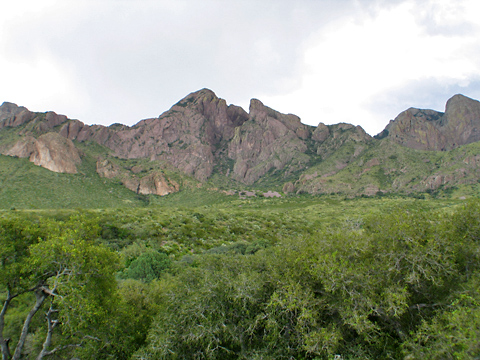
The rock formation in the foreground in this photo is known as La Cueva, because of the cave at its base. More on this famous cave in a later posting.
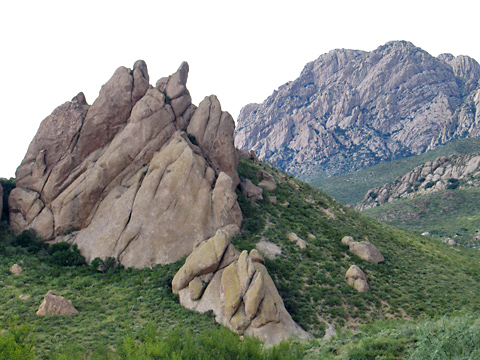
A different view of La Cueva.

The cave is located about the middle of the rock formation, at ground level, where you see several trees. There are three small springs nearby that are difficult to locate, particularly when it’s dry.

These were taken as the sun set.

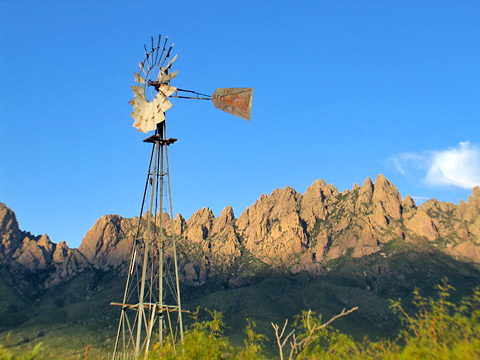
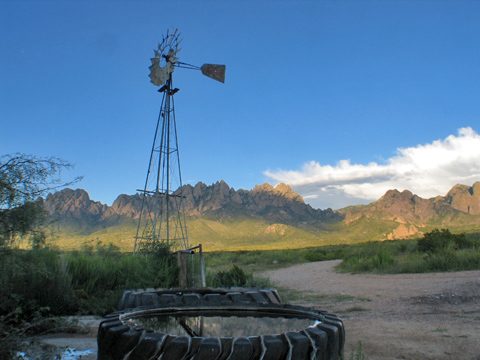
To visit Dripping Springs, take University Avenue/Dripping Springs Road east toward the Organ Mountains. Stay on the road until its end, even after it becomes a dirt road. The last quarter mile before you get to the park is paved.
The park closes at 5 pm. There is a fee for hiking to La Cueva and the other areas of the park, but not for seeing the Visitor’s Center or the always SPECTACULAR VIEWS.
Related Posts:
Hiking Dripping Springs – Part 1
Hiking Dripping Springs – Part 2
Hiking Dripping Springs – Part 3
Tags: Las Cruces, Dripping Springs, Hiking, Windmill, Chihuahuan Desert
Thursday, September 18th, 2008
On October 19, 1929, the Las Cruces newspaper announced the arrival of talkies:
Sound Pictures Coming
A matter of great interest to Las Cruces theatre goers is that tomorrow the Fox Rio Grande Theatre, one block west of Church street, will open up their sound projector system which they have been busily installing for the past week or so. From the character of pictures with sound which have been booked for the coming weeks it is quite apparent that Las Cruces is to have just as high grade entertainment in that line as the largest cities in the country. Las Cruces is to be congratulated upon this fact and it is comforting to know that with this beautiful playhouse, and the installation of this most adequate and modern sound projecting system which is the product of Western Electric and the best made; together with the management afforded by the great Fox West Coast Theatre chain which now owns the Rio Grande, Las Cruces folks will not have to go to El Paso nor anywhere else to see and hear the best shows produced. It is also a matter of satisfaction to Las Cruces people that manager W. L. Gullett is to remain in charge of the management of the Rio Grande.
Las Cruces Citizen, October 19, 1929
Here’s the story behind this highly welcomed event:
Some time in early October 1929, the Rio Grande Theatre was purchased by Fox West Coast Theatres, a distribution and theater ownership company begun in 1921 by William Fox.
William Fox is one of the pioneers – and early heroes – of movies. He got into the film showing business in 1904 by starting the Greater New York Film Rental Company. In 1909, he played an important role in breaking Thomas Edison’s film monopoly, the Motion Picture Patents Company.
In 1915, he founded the Fox Film Corporation to make films, his first film being A Fool There Was staring “sex vamp” Theda Bara.
Business was booming in 1929 and Fox, who always thought “gigantic” and had a “big” reputation for showmanship, decided to celebrate his “Silver Jubilee” of being in the film business with a massive national promotion. On October 12, 1929, he ran the following full-page ad in the Las Cruces Citizen newspaper:

Last week came the Silver Jubilee (25 years) of the Fox Theatres, announced by lavish two-page newspaper advertisements that told of gala performances, mysteriously adding: “Far more important than even the entertainment, will be a message from William Fox of vital concern to the future welfare of every patron of Fox theatres.
In 500 of the 1,100 Fox theatres throughout the U. S. audiences heard this message delivered through Fox Movietone. The birthday gift was advice that Fox patrons buy outright as many shares as they could afford of Fox Theatres Corp. operating and holding company for his gigantic chain. As special inducement they were told of plans for future expansion and the large earnings that were possible.
Expansions promised by Mr. Fox far outstripped the ordinary bounds of showmanship. He promised not only installation of his “grandeur” proscenium-filling screen, and cinema houses devoted to newsreels, but magnificently he offered one fourth of his fortune (which newsmen were permitted to estimate at $36,000,000) to develop visual-oral instruction in schools. “On the theory,” he said, “that one picture is the equivalent of eight words” and that words uttered by college presidents are more potent than those of ordinary teachers, Mr. Fox visualized the time when 15,000,000 or 20,000,000 school children will have school hours reduced from six to three per day by listening to a talkie “educator” instead of to a teacher….
Less convincing than his generosity was Cineman Fox’s foxiness. Offered in 1925, Fox Theatres stock has paid no dividends, has never responded to continued reports of expansion. In 1928 its earnings were $1.91 a share. Previous attempts to distribute the stock, mostly held by speculators, have been unsuccessful. Early this year a group of brokers ran the stock to 37-7/8, but before much was distributed it broke to 21-1/2. Last week it was strong around 28 on belief that the Fox Birthday plan, if successful, will reduce the floating supply.
Time Magazine, Oct. 21, 1929
The coming attractions advertisement that ran in conjunction with the Silver Jubilee announcement showed that the first talkie in Las Cruces was The Flying Fool, staring William Boyd. William Boyd later became famous as “Hopalong Cassidy.” The Flying Fool was followed by Geraldine, The Single Standard, and Diamond Master.


Stock Market Crashes – October 24, 1929
The people who attended the Thursday showing of The Single Standard staring Greta Garbo probably enjoyed it. It’s impossible to say how many people in Las Cruces heard of or worried about the stock market crash that day. Certainly no one knew that people would later consider that event that day — Black Thursday — the beginning of The Great Depression.
On October 26 the Las Cruces Citizen published the advert for the next week’s pictures, clearly marked as talkies.


See Also:
Screen With A Voice – A History of Moving Pictures in Las Cruces, New Mexico
Rio Grande Theatre
Rio Grande Theatre – More History
Tags: Las Cruces, Rio Grande Theatre, Theaters, History, Main Street
Saturday, September 13th, 2008

The Rio Grande Theatre opened on July 29, 1926. The official announcment to the public was made in the July 24 issue of the Las Cruces Citizen newspaper:
RIO GRANDE THEATER OPENS JULY 29
At last we are privileged to announce the definite opening date of the new Rio Grande Theatre built by Seale and Dyne and operated by the Central Theatres Corporation of Denver as Thursday July 29th with the powerful Sea Drama “Mare Nostrum” as created by the masterful director, Rex Ingram with Alice Terry and Antonio Moreno in the leading roles. Mr. Ingram has directed such notable successes as The Four Horsemen of the Apocalypse, and may others. Mare Nostrum is conceded to be one of the outstanding successes of the year and the management was indeed fortunate in securing an attraction of this caliber as an opening production.
A treat indeed is in store for those who have anxiously awaited the opening of this truly wonderful institution which is a great credit to the Southwest, the builders who have had the foresight to visualize the future in their enterprise and the operators for the confidence they have placed in the community in the manner they have equipped the theatre.
Replacing the old style painted scenery, the stage is to be hung and decorated in a lavish manner with velvet drapes and curtains as is the Auditorium proper. The foyer and aisles are carpeted in a rich red and the lightning [lighting] is as modern as has yet been installed in even the larger theatres in the cities.
A washed air cooling system maintains any desired temperature with its clean pure air as distributed scientifically throughout the house, the mammoth organ will be operated by Miss Elsie Dean Bristol who comes direct from one of the corporation’s Denver theatres, which assures all lovers of accurately played pictures a treat in store for them.
— Las Cruces Citizen, July 24, 1926
The first advertisement for the theatre was published in the same issue of the newspaper:

The movie selected for the opening was the silent movie Mare Nostrum, directed by Rex Ingram. The New York Times’ movie critic Mordaunt Hall had given the movie a mixed review on Feb 16, 1926. Even then, the movie critic’s basic stance of a haute attitude and a pseudo-intellectual tone is evident. Some quotes from that review:
“The German submarine and the Wilhelmstrasse spy system during the World War are the theme of Rex Ingram’s picturization of Blasco Ibanez’s “Mare Nostrum,” which was presented last night before an audience that appeared to be left slightly dazed by the weird delivery of the film. It is an effort that in the second half has its full quota of thrills, but in the end it reminds one of the Von Tirpitz edict—”Spurlos Versenkt!” The heroine and the hero have met their deaths and so have the villains; the comedian alone is left to drift back to his Spanish port aboard a flimsy raft.”
“Mr. Ingram goes about the unfolding of this narrative with a dislike of haste. He seems to tell you that you must gaze upon his story as he tells it or not at all, and therefore it is not until just before the first half has come to a close that interest in the picture is really awakened; that happens to be through a scene in which a stout German Frau Doktor of the German Secret Service, her faithful and beautiful aid, Freya Talberg, and a Spanish skipper, drink a toast to the Emperor Josef.”
“The first sequence dealing with the sinking of a British vessel by a submarine is graphically filmed. The Mediterranean is a tame stretch of blue to a wireless operator. He had just said “Hello” to his colleague aboard the Californian. Then one perceives the submersible sneaking after its prey, and subsequently the Californian receives her death blow in an explosion of spray and fire. Aboard the other vessel all is tranquil; then the wireless operator gets the S. O. S., but gradually the sinking ship is covered by water. The commander of the submarine pushes his cap back over his shorn head and checks off the British steamship as having been sunk.”
“Freya is arrested as a spy and taken from Marseilles to the St. Lazare prison, in Paris. In the course of usual motion picture events Freya would have been saved at the last minute. One awaits it in this film. She is taken to Vincennes in the early morning, and the soldiers line up. The buglers sound “Taps” after making a flourish with their brass instruments. Freya had made a petition to be shot in furs, feathers and expensive clothes; it was granted. She had walked proudly to the white stake against which she rests. Her hands had been tied with rope. An officer winces before the order is given to fire. When that order comes the rifles blaze and nothing more is seen of Freya until a weird idea or nebulous figures under the sea is portrayed at the end of the picture.”
“Alice Terry is fair, but unconvincing in the rôle of the German spy. She is too phlegmatic for the part. Antonio Moreno figures as the susceptible Ferragut. Mr. Moreno has plenty of character in his countenance, but he does seem to be a ready victim to a pair of blue eyes.”
“Aside from the effective photography in Spain, Italy and France and the dramatic sequences concerned with the submarine’s deadly work and the shooting of a woman spy, this production does not do justice to the talent of the man who made “The Four Horsemen of the Apocalypse” and “Scaramouche.” His last production, “The Arab,” was lovely but a slow story that did not boast of much in the way of drama.”

Probably no one in Las Cruces at the time read the New York Times’ review. The opening was a big success:
NEW THEATER HAS GRAND OPENING
W. L. Gullett, manager of the new Rio Grande Theater got off to a good start Thursday night when he opened this fine new playhouse because the house was packed and the play was up to expectations, and then some.
It is needless to say that he will continue to have full houses as it is Mr. Gullett’s intention to bring only the best plays.
M. B. Stevens, the popular realty man, made an address that took big. If “Mo” decides to throw his old chapeau into the political ring, the La Estella will get right behind his candidacy.
Las Cruces Citizen, July 31, 1926
As was standard in those days, the Rio Grande Theatre changed its movies every week. Here’s the showing for the second week, July 31, 1926:

Here’s the newspaper ad for week three, Aug 7, 1926:

See Also:
Screen With A Voice – A History of Moving Pictures in Las Cruces, New Mexico
HANG ‘EM HIGH
For more photos of the Rio Grande Theatre see this prior post.
Las Cruces Gets Talkies.
Tags: Las Cruces, Rio Grande Theatre, Theaters, History, Main Street
Wednesday, September 10th, 2008
After a very dry winter, spring, and summer, we have been getting some FINE rains. As a result, the desert around Las Cruces is greener than I can remember it ever being. It’s not just the amount of rain, probably, but it’s also the timing.
Here are some photos today taken at the base of Soledad Canyon, in the Organ Mountains.


Soledad Canyon is a public park and a wonderful place to hike. It’s about a 12 minute drive from NMSU.
To visit Soledad Canyon, take University Avenue/Dripping Springs Road east for about 4.5 miles, then turn south on the Soledad Canyon Road. That road will turn east toward the mountains in a mile; follow it all the way to the end. For the last fifth of a mile the road is unpaved; it ends at the park’s parking area.
If hiking in the park, be sure and register at the map box at the foot of the trail. You can bring your dog[s]. The park permits day use only.
Tags: Las Cruces, Soledad Canyon, Windmill, Chihuahuan Desert
Saturday, June 14th, 2008
A fire, apparently arson, started today about 5:30 on the Las Cruces side of the Organ Mountains. The origin was evidently just south of Dripping Springs.
By late evening about 400 acres had been burned. Several homes were evacuated. The old sanatorium ruins at Dripping Springs are evidently not at risk.

June 17 — The fire is basically out. Fire fighters from as far away as Lincon and Silver City helped fight it.
Friday, October 19th, 2007
As noted here, the just restored Rio Grande Theatre was designed by Otto H. Thorman, an El Paso architech.
That was not his only theatre project. He also designed the Mission Theatre in El Paso.

The theatre, at 3031 Alameda, was built in 1940 for the El Paso Amusement Company. It is now a bar.

The Spanish mission theme is obvious. The bell is still in the bell space.
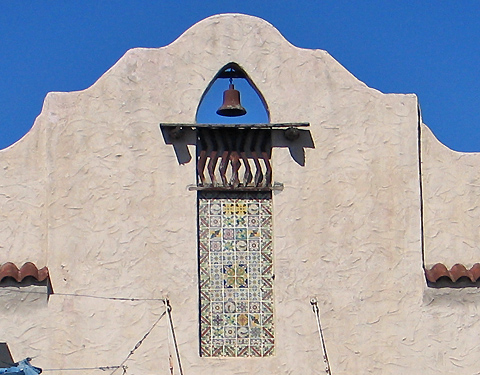
Tags: El Paso, Mission Theatre, Theaters
Tuesday, October 16th, 2007

Rio Grande Theatre, Main Street, Las Cruces.
In 1925, the Hacker Hotel was torn down to provide a site for The Rio Grande Theatre. An El Paso architect, Otto H. Thorman, was hired to design the theatre, which is built of adobe. A “washed air” cooling system was installed — which must have been very rare in New Mexico then.
The theatre opened on July 29, 1926 with the film Mare Nostrum (a silent film), directed by Rex Ingram and staring Alice Terry and Antonio Moreno.
Prices for movies were 40 cents for the main floor, 30 cents for the balcony, and 15 cents for children.
In 1933, the theatre burned, but it was rebuilt and restored, even though it was the Great Depression.

The theatre remained in operation until 1997, when it was closed as no longer economically viable. It was feared it would be destroyed or put to another use.
The theatre was saved by the generosity of the descendents of one of the original owners, who donated the portion they owned (thank you!), and the Dona Ana Arts Council, which raised the money to purchase the rest and to restore the theater.
The restoration process began in 2001 and the was completed sufficiently by 2005 for a grand opening.

The marquee, restored to its original look.
The original facade was covered some time in the 50s. When the new front was removed, the original decorations, although damaged, were discovered. In a 1933 newspaper article, the decorations are described as “color combinations of reds, yellows, and blues.” They are almost completely restored, except for these few:

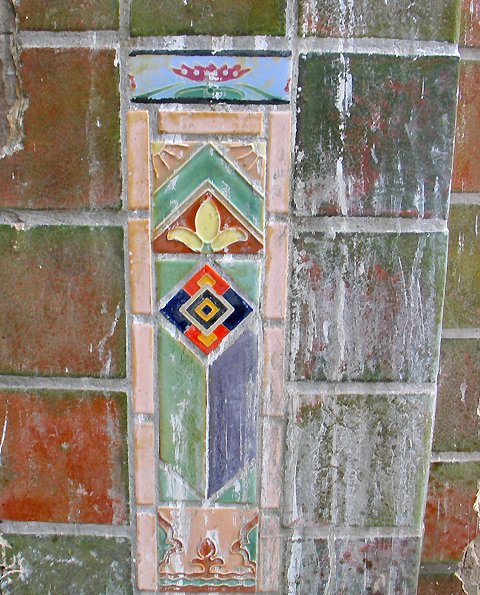

Here’s the restored ticket booth:

The beautifully restored interior now seats 422:
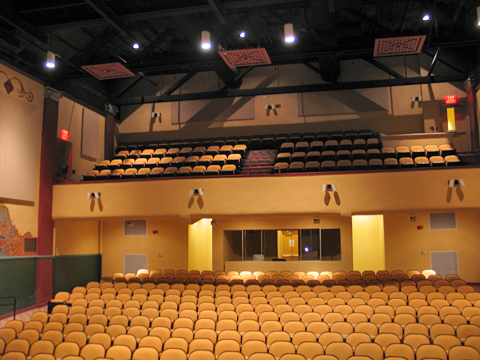
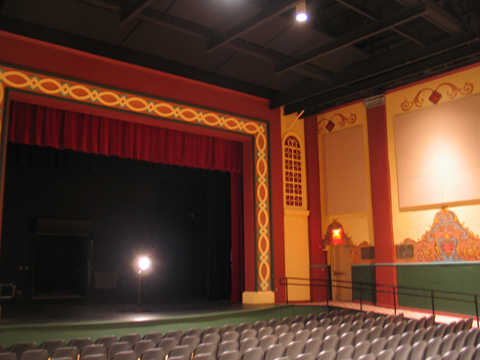
Notice the “ghost light.” (A “ghost light” is a single bulb burning on a dark stage, an old English tradition.)
Some photos of the restored ceiling:


(Historial information provided by the Dona Ana Arts Council.)
See Also
Screen With A Voice – A History of Moving Pictures in Las Cruces, New Mexico
HANG ‘EM HIGH
Rio Grande Theatre – More History.
Las Cruces Gets Talkies.
Tags: Las Cruces, Rio Grande Theatre, Theaters, History, Main Street
Thursday, September 27th, 2007
In reply to an inquiry as to how Las Cruces, New Mexico, “the City of Crosses,” got its name, Judge Charles Blanchard, of Las Vegas, who is located in Las Cruces temporarily, handling lands and mines, writes to The Optic as follows from that city:
“I have renewed here the acquaintances of many old settlers, some of whom I have never seen but whose names were familiar through business connections in the early days; from the early 1840’s until the advent of the railroad in New Mexico, during the good, old times of wagon freighting from Chihuahua to [the] Missouri river, by way of Las Vegas, where I was initiated into the mercantile business that commanded the patronage of this portion of New Mexico in its full breadth from east to west and along the Rio Grande [and a] hundred miles into Texas.
I read the other day the register of the old Mesilla hotel, rendered famous as the rendezvous of many pioneers of the southwest, at that time that Soccorro county extended from Arizona to the west line of Texas, when the present “Lincoln” was known only by the name of Fort Stanton and the old town of Tularosa. Such names as John Chisum, Col. Emil Fritz, Major Murphy, Capt. J. C. Lea, Col. A. J. Fountain, Col. Rynerson, Jimmy Dolan, Joseph Reynolds, Pat Garrett, A. Griggs and a host of other familiar figures often appear upon the leaves of the records of the ancient hostelery of Mesilla.
In the old town of Mesilla are several families with centenarians, one of whom is living with members of four generations in the same house, due, of course, to simple, frugal living, and exploding the theory that longevity is produced by modern, scientific preparations of diet.
Mesilla is one of the oldest settlements in the southern New Mexico, and has consequently been the scene of many thrilling adventures and historic events. Being on the main road between Santa Fe and Chihuahua, it was a settlement of no small importance, and when in 1865 Silver City began to loom up as a mining camp, a wagon road was opened from Mesilla through Cook’s Peak and Stein’s pass, of Indian massacre fame, and it added much to the importance of the old town. El Paso and Las Cruces were not known then; the town of Dona Ana, seven miles up the valley, being the only settlement as a rival as a trading post and county seat.
In 1852, a long caravan of forty five carts drawn by oxen, heavily loaded with freight from Santa Fe to Chihuahua merchants were one morning nearing a point where the Lucero flouring mill now stands, the northern suburb of Las Cruces, where the convoy was attacked by the Mescalero-Apaches and entirely destroyed, some fifty men being killed and buried on the spot. The native cart was constructed without bolts of iron and the creaking of the wheels could be heard at great distances, when in motion.
The news of the disaster was conveyed to Dona Ana where some troops were stationed. The men were buried in separate graves marked with mounds and a cross on each grave. Ever since the spot has been designated as that of Las Cruces, the present City of Crosses.”
— Rio Grande Republican, Feb 13, 1909 (newspaper)
Tags: Las Cruces, History
Tuesday, September 11th, 2007

The Organ Mountains behind a row of tractors.
Tags: Organ Mountains